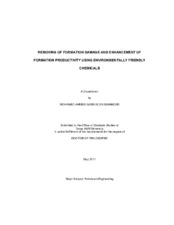| dc.description.abstract | Matrix acidizing is used in carbonate formations to create wormholes that connect the formation to the wellbore. Hydrochloric acid, organic acids, or mixtures of these acids are typically used in matrix acidizing treatments of carbonate reservoirs. However, the use of these acids in deep wells has some major drawbacks including high and uncontrolled reaction rate and corrosion to well tubulars, especially those made of chrome-based tubulars (Cr-13 and duplex steel), and these problems become severe at high temperatures. Hydrochloric acid (HCl) and its based fluids have a major drawback in stimulating shallow (low fracture gradient) formations as they may cause face dissolution (formation surface washout) if injected at low rates. The objective of stimulation of sandstone reservoirs is to remove the damage caused to the production zone during drilling or completion operations. Many problems may occur during sandstone acidizing with Hydrochloric/Hydrofluoric acids (HCl/HF) mud acid. Among those problems: decomposition of clays in HCl acids, precipitation of fluosilicates, the presence of carbonate can cause the precipitation of calcium fluorides, silica-gel filming, colloidal silica-gel precipitation, and mixing between various stages of the treatment. To overcome problems associated with strong acids, chelating agents were introduced and used in the field. However, major concerns with most of these chemicals are their limited dissolving power and negative environmental impact.
Glutamic acid diacetic acid (GLDA) a newly developed environmentally friendly chelate was examined as stand-alone stimulation fluid in deep oil and gas wells. In this study we used GLDA to stimulate carbonate cores (calcite and dolomite). GLDA was also used to stimulate and remove the damage from different sandstone cores containing different compositions of clay minerals. Carbonate cores (calcite and dolomite) of 6 and 20 in. length and 1.5 in. diameter were used in the coreflood experiments. Coreflood experiments were run at temperatures ranging from 180 to 300oF. Ethylene diamine tetra acetic acid (EDTA), hydroxyl ethylethylene diaminetriacetic acid (HEDTA), and GLDA were used to stimulate and remove the damage from different sandstone cores at high temperatures. X-ray Computed Topography (CT) scans were used to determine the effectiveness of these fluids in stimulation calcite and dolomite cores and removing the damage from sandstone cores. The sandstone cores used in this study contain from 1 to 18 wt percent illite (swellable and migratable clay mineral).
GLDA was found to be highly effective in creating wormholes over a wide range of pH (1.7-13) in calcite cores. Increasing temperature enhanced the reaction rate, more calcite was dissolved, and larger wormholes were formed for different pH with smaller volumes of GLDA solutions. GLDA has a prolonged activity and leads to a decreased surface spending resulting in face dissolution and therefore acts deeper in the formation. In addition, GLDA was very effective in creating wormholes in the dolomite core as it is a good chelate for magnesium. Coreflood experiments showed that at high pH values (pH =11) GLDA, HEDTA, and EDTA were almost the same in increasing the permeability of both Berea and Bandera sandstone cores. GLDA, HEDTA, and EDTA were compatible with Bandera sandstone cores which contains 10 wt percent Illite. The weight loss from the core was highest in case of HEDTA and lowest in case of GLDA at pH 11. At low pH values (pH =4) 0.6M GLDA performed better than 0.6M HEDTA in the coreflood experiments. The permeability ratio (final/initial) for Bandera sandstone cores was 2 in the case of GLDA and 1.2 in the case of HEDTA at pH of 4 and 300oF. At high pH HEDTA was the best chelating agent to stimulate different sandstone cores, and at low pH GLDA was the best one. For Berea sandstone cores EDTA at high pH of 11 was the best in increasing the permeability of the core at 300oF.
The low pH GLDA based fluid has been especially designed for high temperature oil well stimulation in carbonate and sandstone rock. Extensive studies have proved that GLDA effectively created wormholes in carbonate cores, is gentle to most types of casing including Cr-based tubular, has a high thermal stability and gives no unwanted interactions with carbonate or sandstone formations. These unique properties ensure that it can be safely used under extreme conditions for which the current technologies do not give optimal results. Furthermore, this stimulation fluid contributes to a sustainable future as it based on readily biodegradable GLDA that is made from natural and renewable raw material. | en |


